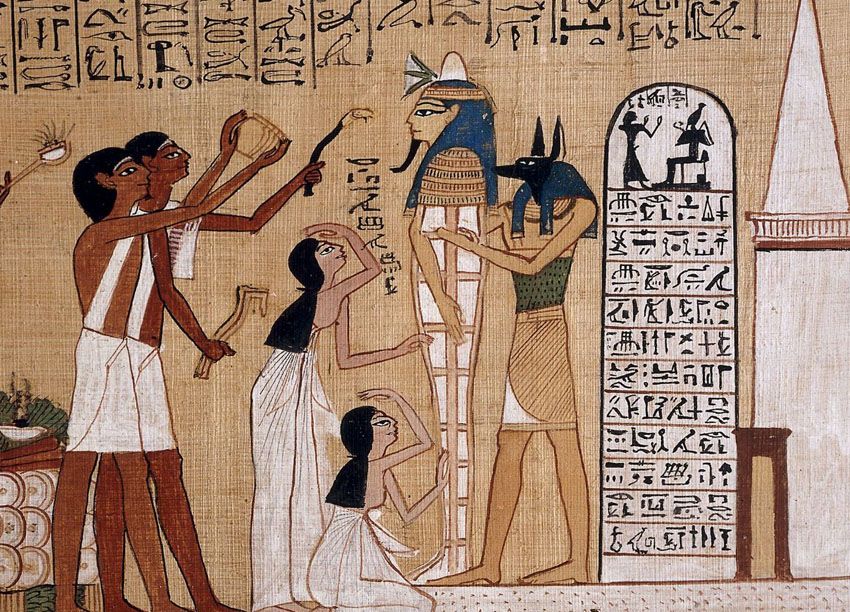Anubis

Let's get in, let's get deep. Six feet deep!
I thought with all the secrets and indentities revealed in the story, we could get up close and personal with everyone's favorite Lord of the Dead, Anubis! Also known as Anpu, or Anapa, or sometimes confused with Wepawet, later known as Hermanubis, First Among Secrets, Foremost of Westerners, Lord of the Sacred Land, Ruler of the Bows- and more. A lot more! Anubis has been around a long time and was popular even in later times when Egypt was under Graeco-Roman rule.
The people of Egypt created Anubis when their burial sites kept getting dug up by wild dogs and jackals. As was popular back in the day, to appease the animals they created a god to pray them away- or at the very least change their mind. Eventually, they considered the jackals to be protectors of the dead. Even the howls at night were considered prayers of protection over their kin. That's why Anubis is not only pictured as the jackal animal, but a human with a jackal head. And just like Osiris who's symbolically given green skin to represent vegetation (also zombie reasons), Anubis is given black fur to symbolize the discoloration of a corpse during mummification. It's also to represent the color of the fertile soil, as a symbol of regeneration.
Nowadays, it's difficult to find funerary texts without the black jackal. Anubis' cult was extremely popular, his cultural worship centre in what the Greeks would name 'Cynopolis' (city of dogs). Before Osiris died so hard he became King of the Underworld, that was Anubis' job! Though it's actually thanks to being apart of the Osiris family that Anubis is so well-liked.
Speaking of which, there's some debate over Anubis' linneage. In Early days, Anubis was considered 'the fourth son of Ra,' according to Pyramid texts. There are others that say Hesat the cow goddess was his mother, another Bastet, or that it was Set and Nephythys (yes including Wikipedia). It's Plutarch who says that Set left his consort Nephthys childless- so she got Osiris drunk and had him impregnate her. Thus Anubis is conceived. Disgusted with her actions, Nephthys abandons the child. Isis discovers him and raises him herself. And this was all before Horus!
Anubis is extremely close with the family of Osiris. He tags along with the King when he goes on his walk of the land, and it's when Osiris dies that Anubis invents funerary rites and the act of mummification to preserve the body. When Isis is on the run from the followers of Set and has to give birth to Horus, it's Anubis that protects her. Because of this not only is Anubis credited with God of Mummification, he's also painted on the walls of birth houses to protect the babies born there.
However, when most of us think of the image of Anubis, we're picturing him in full-on funeral rites. And it's no wonder. He's involved in almost every step!

He's there at the embalming,

the Opening of the Mouth Ceremony,

the weighing of the heart,

and even guiding the deceased up to Osiris to say hello and give offerings! During the actual ceremonies of the funeral, priests would mimic these actions by wearing a clay Anubis mask.
But as time went on, and the Egyptian Pharaohs gave way to Greek rulers, Anubis' role and form changed too. They loved Anubis. They compared him to their own Hermes, as a 'Conductor of the Dead'. It's around this time he gets the name 'Hermanubis'. He would go on to be a deity of cosmic proportions, bringing with him arcane wisdom and light for humanity. It's Plutarch again who comes in, calling Anubis a 'messenger between heaven and hell, displaying alternately a face black as night and golden as the day.'
That's it for Anubis! The books I read were as follows
Who's Who in Egyptian Mythology by Anthony S Mercatante
Egyptian Mythology by Paul Hamlyn
Egyptian Symbols by Heike Owusu
The Complete Gods and Goddesses by Richard Wilkinson
